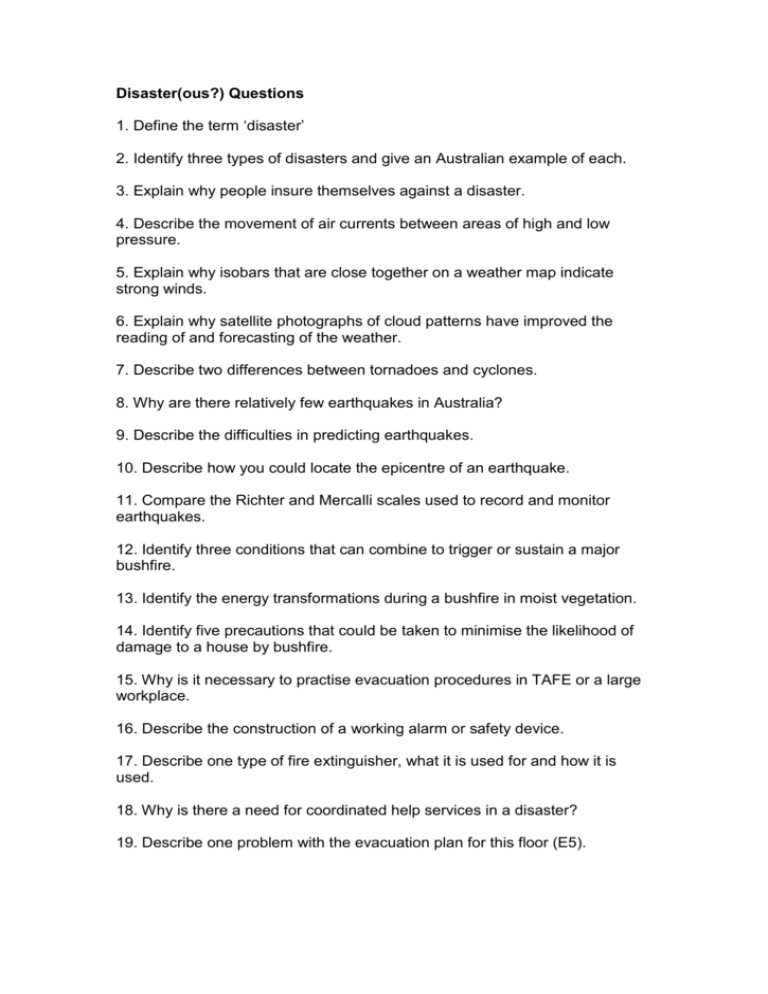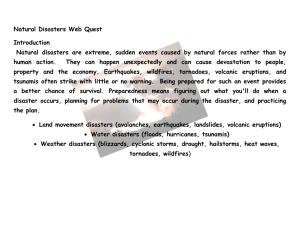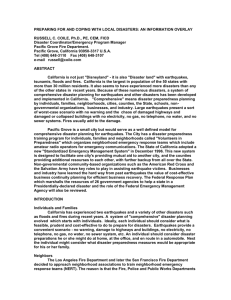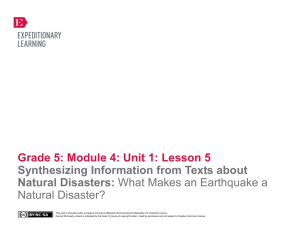Disaster questions
advertisement

Disaster(ous?) Questions 1. Define the term ‘disaster’ 2. Identify three types of disasters and give an Australian example of each. 3. Explain why people insure themselves against a disaster. 4. Describe the movement of air currents between areas of high and low pressure. 5. Explain why isobars that are close together on a weather map indicate strong winds. 6. Explain why satellite photographs of cloud patterns have improved the reading of and forecasting of the weather. 7. Describe two differences between tornadoes and cyclones. 8. Why are there relatively few earthquakes in Australia? 9. Describe the difficulties in predicting earthquakes. 10. Describe how you could locate the epicentre of an earthquake. 11. Compare the Richter and Mercalli scales used to record and monitor earthquakes. 12. Identify three conditions that can combine to trigger or sustain a major bushfire. 13. Identify the energy transformations during a bushfire in moist vegetation. 14. Identify five precautions that could be taken to minimise the likelihood of damage to a house by bushfire. 15. Why is it necessary to practise evacuation procedures in TAFE or a large workplace. 16. Describe the construction of a working alarm or safety device. 17. Describe one type of fire extinguisher, what it is used for and how it is used. 18. Why is there a need for coordinated help services in a disaster? 19. Describe one problem with the evacuation plan for this floor (E5). Answers (these are brief, you might need to elaborate in an exam) 1. A disaster is when there is substantial damage to the environment or structures and/or loss of life. 2. Natural: Cyclone Tracey/Larry or Newcastle earthquake; Human: Granville train disaster; Combination: Thredbo landslide. 3. The costs of recovering from a disaster can be too high for an individual 4. The air moves between areas of high pressure and areas of low pressure causing winds. 5. Close isobars indicate a rapid drop in pressure, so the air is moving quickly. 6. Satellite pictures enable the location and movement of air masses represented by clouds to be easily tracked, allowing more accurate estimations of the future location of the cloud mass to be made. 7. Tornadoes are not associated with rain, cyclones are. Tornadoes are short lived (minutes or a small number of hours), cyclones exist for days, tornadoes tend to have a lower pressure and faster winds than cyclones. 8. Australia is in the middle of a plate, most earthquakes occur at the junction of plates, so Australia only has small numbers of earthquakes due to small local faults. 9. There are no observable signs that an earthquake is about to occur. Long term monitoring of the frequency and severity of earthquakes can give a broad indication of the likely frequency and severity of an earthquake, but cannot identify exactly when and where. 10. If you have the time distance between the arrival of P and s waves for three stations, it is possible to use this to work out the epicentre. 11. Richter gives a scientific calculation of the energy of an earthquake, Mercalli gives a description of the effect from observers. The Mercalli scale can vary from the Richter scale because of the number and construction of buildings; the underlying geology (sand can cause greater collapse of buildings than rock). 12. Low humidity, high temperature, strong winds 13. Chemical energy (fuel)is transformed into light, heat and smaller amounts of sound and kinetic energy. Some of the energy is used to turn the water in the moist vegetation into gas, then it is burnt. 14. Clean gutters, screen any vents, keep lawn short, remove any flammable material (leaves etc) from around the property, keep trees away from the house; 15. So people know what to do so if a real emergency occurs everyone can get out quickly and safely. Also helps to identify any problems with the evacuation drill. 16. 17. Carbon dioxide (red with black band) is used for most fires including paper and electrical. Follow instructions on the bottle. 18. To avoid duplication of services and ensure that all steps necessary are taken (and not left for someone else to do ie no one). A coordinator has the power to shut down services and order evacuations. 19.











